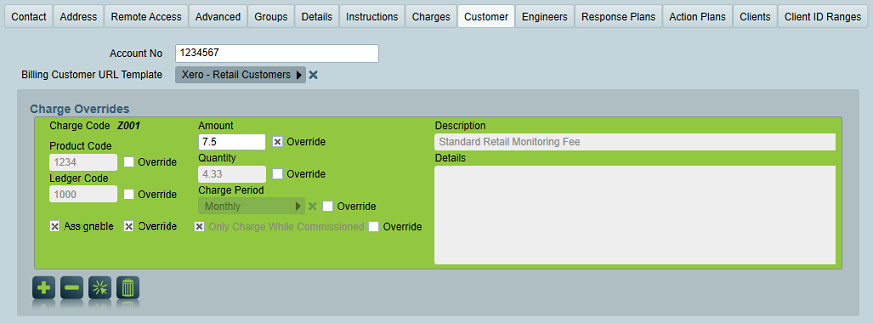Billing Customer Modes
In the System Wide Settings is an option to control the billing mode being used. The standard billing mode explicitly assigns billing customers for charges, making it easy to see who is being billed for each charge. In legacy billing mode, a combination of direct client billing and dealer billing is configured in the billing batch runs.
Standard Customer Billing
When the 'Legacy Customer Billing' system setting is disabled then Standard Customer Billing is used.
In this mode, users can be designated as a billing customer, and have charges/billing invoices linked to them.
Billing Customer Setup
In User Maintenance, a checkbox 'Enable Billing' will be available. Marking a user as a billing customer adds an additional 'Customer' tab, where customer-specific details can be entered. Any type of user can be marked as a customer, including Installers/Dealers.

Ensure the Account No field is entered, as this identifies the customer in the accounting package.
The Billing Customer URL Template setting can be used to select the Billing URL template for this customer. If not selected, the Default Billing Link setting in System Wide Settings is used. This is useful when URL links differ based on the customer. E.g. if your accounting software package has been partitioned into multiple customer databases. See Billing Overview for more information.
Customers can also override the default amount/quantity and other details of specific charges where appropriate. See Billing Charges for more details.
It is not required to assign the billing customer to each client, although they can be assigned if convenient or if the user is already assigned to the site.
Customer Assignment
When a charge is assigned, it must be associated with a specific customer who will be responsible for the charge. The method for doing this depends on the type of charge.
For Service Charges, the customer can be selected when assigning the service charge to the client.
For Work Orders and Dispatch Jobs, one customer is selected for the entire job.
Default Customer
In the common case that a single customer is responsible for all charges on a client, a Default Customer can be assigned on the Billing Tab. This default customer will be used for all service charges, work orders, dispatch jobs etc. on the client which do not have an explicit customer assigned.
If there is no explicit customer and no default customer for a charge, a warning/error will be reported.
Legacy Customer Billing
When the 'Legacy Customer Billing' system setting is enabled, explicit customer users are not used, and instead the batch run controls who is billed for each assigned charge.
Legacy billing supports two separate billing options:
-
Client Direct Billing
- In this mode, the client is billed directly, and each client receives their own separate invoice
- On the Billing Tab, ensure the Account No field is entered, as this identifies the client in the accounting package.
-
Dealer Billing
- In this mode, each dealer receives a consolidated invoice covering all of their clients
- In the Installer Details, ensure the Account No field is entered, as this identifies the dealer in the accounting package.
It is possible to use a combination of Client Direct Billing and Dealer Billing, by using separate charge codes for each and configuring the Batch Billing Runs to match.